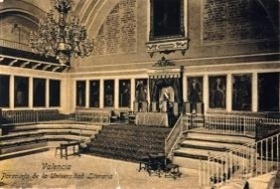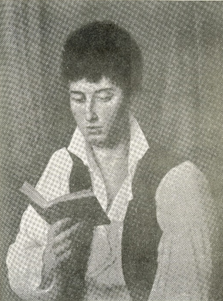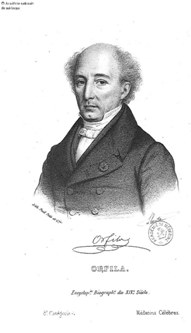
Mateu Orfila i Rotger
The magnificent main hall of the University of Valencia is one of the most important symbolic spaces of this institution. It is the site of the most relevant academic celebrations such as the opening of the course and the award of honoris causa doctorates and extraordinary awards. The space was built in the seventeenth century, but was substantially refurbished in 1869 by the architect Sebastià Monleon, also the author of other emblematic spaces of Valencia. At the moment the walls of the auditorium are occupied by a gallery of portraits that represent different rectors of the University. Presiding the main façade we find a seventeenth century picture that represents the Immaculate Conception, which is flanked by two semicircular sections with columns of names of illustrious Valencian scholars in golden letters. Among this list is Mateu Orfila, a very famous nineteenth-century toxicologist, thanks in particular to the poisoning trials in which he participated. This popularity and other reasons that we will discuss later explain his presence in a place as emblematic as the main hall of the University of Valencia, although he was born in Maó and he only resided in Valencia for a few months, when he was studying at the Faculty of Medicine. The presence of Orfila will be even more surprising in the exclusive list of the main hall, after reading his demolishing opinions regarding the University of Valencia, expressed in his family letters, which have recently been published. With these documents we can find a look about the university from an almost absent perspective of the institutional archives: that of a young student at the beginning of a medical career in the early nineteenth century. Only his later fame and the work of a large number of scholars in Menorca have allowed the preservation of this valuable testimony with which we will build a good part of this article.
Mateu Josep Bonaventura Orfila i Rotger (1787-1853) was born in Mahon on April 24, 1787. Several circumstances of his youth in Minorca were decisive for his future career. In the first place, with an economically favourable family context, Orfila obtained a good education in elementary subjects and also soon gained a good knowledge of modern languages such as French and English, thanks to the existence of exiles and the changing circumstances of Island policies during the eighteenth century, dominated at different times by the British, French and, finally, Spanish monarchy. These particularities allowed an eighteenth century propitious for intercourses, migrations and cultural influences of many types, as can be seen in the architecture of the island and in many expressions of the Catalan of Menorca. This was the language used by many illustrated Minorcan and also by young Orfila in his first writings.
Orfila also began in Menorca his musical training as a singer in a church choir, apparently as a therapy to fight a persistent stuttering. We will later see that they would be fundamental abilities for his scientific and academic career. The first science lessons that he received in Mahon were also important in this regard, thanks in particular to the professor of Germanic origin Carl E. Cook. These classes showed Orfila the need for practical demonstration, instruments and experiments within the teaching of sciences. Finally, contacts were also made with the doctor at the hospital of Mahon, Antonio Hernández Morejón, former student of the University of Valencia and also present in the exclusive list of the university main hall. Most likely the conversations with Morejón inspired Orfila’s trip in the fall of 1804 to study medicine in Valencia.
The studies had been updated with the new plan of rector Blasco, who introduced the teaching of chemistry with the creation of a small laboratory. Even so, the university atmosphere was very disappointing for the young Orfila. The Faculty of Medicine of Valencia had a good reputation. He encountered a theoretical teaching aimed at memorising contents, obsolete and without updating manuals, endless academic disputes, few practical activities and almost no experimental demonstrations, lack of interest from teachers and student desires, and, as Orfila denounced in his family correspondence, many parties and a few study hours. With the help of an illustrated military man, Joan Sánchez Cisneros, an active member of the Economic Society of Friends of the Country of Valencia, Orfila was able to study chemistry on his own. He read the works of the most famous French authors and developed small experiments at home. This self-taught formation allowed him to stand out among his peers and win an award after a public contest highly praised in the Valencian press. The official report of the event indicated that Orfila was well acquainted with “mathematics and physics, as well as the Latin, French, Italian, and English languages”, thanks to which he had been “able to read chemistry works little-known by other students”. In fact, many of his colleagues only knew what was indicated by the obsolete official manual (written by Pierre Macquer and translated by the University of Valencia in 1788), which still indicated that the air and water were elemental substances, although many years earlier these ideas of Aristotelian origin had been abandoned, thanks to the so-called “chemical revolution” starring Antoine Lavoisier and other chemists of the late eighteenth century. Orfila knew the manuals of these French authors he had been accumulating and reading in his apartment in Valencia, where he had created a small laboratory to carry out experiments and practice the main chemical operations.
Orfila thus obtained, outside the university classrooms, a good chemical training, which allowed him to win the aforementioned public contest and, as we will see, to make a very unique career in the field of toxicology. It is not surprising that this outstanding training also provoked the rejection and misunderstanding of his peers. When he mentioned the new chemical knowledge in the classes, the medical professors protested: “Here we have Mr. Oxygen and Mr. Hydrogen”. Orfila was furious over the large number of academic parties (“there are only 55 or 56 schooldays per year”) and the students’ indiscipline in the classrooms made him even more mad: “some smoke, others speak, others sing and what teachers want is that students remain as dumb as themselves”. His opinion about teachers was also negative: “they are pedantic, as all of Spain knows... they only know how to make cigarettes and smoke”. This scenario became even more unbearable after an unfortunate encounter with the Inquisition, caused by Orfila’s unorthodox statements about the age of the Earth. In August 1805, Orfila wrote to his father to indicate that he would rather “die” before remaining one more day at the University of Valencia, which he described as “the mother of barbarity”.
Orfila decided to continue his training in Barcelona, where he probably attended classes at the College of Surgery (there was no Faculty of Medicine in Barcelona after 1714). He intensified his chemical training with the courses organised by Francesc Carbonell i Bravo at the Barcelona Trade Board. Through a favourable report from his professor, Orfila obtained a scholarship (or “pension” according to the expression of the time) and thus he was part of the select group of “pensioners” who travelled to several European capitals to continue his training during the last years of the Enlightenment. Unlike the first travellers of the previous decade, most of the “pensioners” of the generation of Orfila could not develop a scientific career in their country for several reasons, mainly due to the economic crisis of the institutions that encouraged travelling, where they were supposed to join when returning. In this unfavourable situation, the destructive effect of the Napoleonic wars and, much more devastating, the measures of repression towards liberal and Frenchified ones of the regime of Ferdinand VII of Spain were added.
Orfila was not directly affected by this political repression suffered by many pensioners of his generation. The Peninsular War meant the cancellation of the scholarship in Paris, when he was in the second year of the studies in the prestigious Faculty of Medicine.
With the economic help of his family, Orfila decided to continue in the French capital, where he finished the medical career with a thesis on urine chemical analysis, presented in December 1811. At the same time, Orfila initiated two activities that would be decisive for his career: musical evening events in the Parisian halls (where he became a famous singer) and his private science courses. His excellent musical skills allowed him to contact many notable French society members, who later would be key supporters during crucial moments of his life. Private classes were also important both for academic prestige and for his diminished economic resources. If we accept Orfila’s memories described in his autobiography, these private courses were also a starting point for their toxicological investigations. They allowed him to perform a large number of experimental demonstrations, experiments with animals and chemical tests, and he thus acquired a great skill with the laboratory techniques.
Combining medical training and his exceptional abilities for chemistry, Orfila was able to write during 1813 the treatise of poisons that made him famous: Traité des poisons (Paris, 1814-1815). With a large number of editions and translations, this text was a fundamental tool for the development of nineteenth-century toxicology and is considered a crucial milestone in the development of this science. In the following years the second of his important works appeared: Éléments de chimie (Paris, 1817). Although much less well-known, this manual was used for training a whole generation of nineteenth-century chemicals: it was periodically re-published for almost four decades and translated into many European languages. These publications led to a growing academic recognition, as well as a new source of income, two equally important aspects that Orfila continued to increase with the publication of a small manual of first aid disclosures in case of poisoning (Secours à donner aux personnes empoisonnées et asphyxiées, Paris, 1818). The publication of this work was possible thanks to the support of the French government. He also obtained, with the help of the friendships of the halls, a lucrative place of royal doctor. All this favourable context explains that Orfila could reject an offer from the Spanish government to occupy a chair of chemistry in Madrid. “Spain does not have a cent”, he wrote in November 1815 to his father, “I will not leave this country [France], where I will perfectly be three or four years, if they do not pay me accordingly.” This episode has been mentioned many times by historians and commentators of all kinds, who have considered it a precedent of the “brain drain”, similar to that we have suffered in recent years as a result of ultra-conservative policies and cuts within the field of science.
The definitive permanence of Orfila in Paris was confirmed with his marriage to Gabrielle Lesueur (a young woman from a family of French artists) and the acquisition of French nationality, a necessary condition for presenting himself to a competition for a professor’s place in the Faculty of Medicine in Paris, which he won at the beginning of March 1819. The next day he proudly wrote to his sister: “Yesterday at four I was appointed Professor of Legal Medicine ... At the age of 31 years and 10 months I see myself as a professor of the first [medical] school in the world, that is, it is impossible for me to be more”. Orfila remained all his life within this institution. He was not affected by the purging of the Liberals of the Faculty of Medicine in Paris in the autumn of 1822. On the contrary, the dismissal of his teacher and protector Nicolas Vauquelin allowed Orfila to obtain the chemistry chair, which would keep until his death. Orfila’s career would culminate during the Louis-Philippe government, when he was appointed Dean of the Medicine Faculty of Paris, at the same time, following a very habitual practice in France at that time, he accumulated a large number of positions within the administration and enjoyed great academic power within French medicine during the years from 1830 to 1848.
Taking advantage of this predominant position, Orfila developed many important reforms: the extension of the spaces for practical education of the Faculty of Medicine, the creation of new anatomy museums, the organisation of practical laboratories of chemistry, the management of Private courses offered by external professors, the limitation of access to students with the demand for more scientific training, and the reform of the secondary schools of medicine, where pharmaceuticals and “officiers de santé” were trained, a medical degree particularly important in the rural world, which Orfila tried to eliminate.
Orfila was not so strict, although he had criticised it during his years in Valencia, regarding practices of nepotism and endogamy that were more and more common in the Faculty of Medicine of Paris. In a few decades it ceased to be the vibrant and innovative institution of the early nineteenth century, the centre of what Michel Foucault described as the “clinical revolution”, and that attracted students from all over the world with the prestige of their teachers. In the middle of the nineteenth century there was little that remained of this splendour, which had given way to a set of family genealogies, increasingly decadent and mediocre, which were perpetuated during the decades ahead, and left very little of space for innovation and renovation. Orfila was not, by far, the one who took the most advantage of these practices, but it is also true that he achieved, without too much difficulty, that his brother-in-law Octave Lesueur became director of the chemistry laboratory and also that his nephew Louis Orfila obtained a position of tenure-track professor. There are much more spectacular cases, such as the family of the surgeon Antoine Dubois: his son, four brothers-in-law and even three grandchildren managed to be professors of the Faculty of Medicine in Paris. It does not seem that Orfila, during his years as a dean, had the intention (or the ability) to fight against these practices that led to the great Parisian medical institution to an impasse, as indicated by the great historian of medicine Erwin H Ackerknecht in the most famous historical study regarding this institution.
On the contrary, Orfila did determinedly and firmly fight against student revolts of republican inspiration, very virulent in the central years of the 1830s. Students often protested against what they considered nepotism in teacher contests. Other times the revolts were connected with the great republican manifestations against the monarchic governments and the limitations of the press freedom. Orfila used all his power to control these revolts, imposed discipline and sanctions on the most revolutionary students, and restricted access to classrooms or even suspended his courses when there were widespread protests. All these actions, added to his prominent place within the medical and educational institutions, explain the identification of Orfila with the monarchist regime, which allows us to understand its sudden destitution shortly after the Revolution of 1848.
During these years, Orfila became famous for two additional reasons: the musical evening events that he organised in his hall and his participation in poisoning trials. Orfila’s wedding hall was a meeting place for powerful people, doctors, lawyers and young artists with the intention of doing a career in the competitive Parisian music world. Orfila was a member of musical societies, organised concerts and sometimes sang fragments of the most famous operas of the time. The Parisian halls also served for discreet meetings, exchanges of information and business of all kinds. In the last years of his life, Orfila affirmed that many notable advances in his career had been achieved through informal conversations in the halls, not so much in academies and official offices.
Orfila also gained great popularity as an expert during poisoning trials. This activity of Orfila, initiated at the beginning of the 1820s, reached the maximum levels during the final years of the next decade, when the arrival of new toxicological techniques of high sensitivity, along with the increasing wave of poisonings and the participation in very media judgments, transformed Orfila into the most famous toxicologist in all of Europe. The best known court case is the one associated with Marie Lafarge, a young woman from the Paris high bourgeoisie who allegedly poisoned her husband with some pies filled with arsenic. The trial had four different and contradictory expert tests, which generated a wide range of confronted opinions and, subsequently, a giant production of various legal, medical and literary texts, both in France and in many other countries. With the participation of republican activists such as François-Vincent Raspail, and also the main critic of the methods of Orfila, the debates were enlarged with a very broad set of political, social and medical issues: the reliability of the arsenic analysis methods, the selection of the various experts, the limits of the jury in cases with complex expert evidence, the role of the press and parallel judgments, the relative value of expert evidence and testimonies, etc. The controversy generated explains Orfila’s 1843 decision in order to avoid the courts of justice. The decision was temporary so that Orfila would return to the last years of his life, although never again with the authority of the previous period.
Engraving based on a daguerreotype of Orfila in the last years of his life. In the table there are three main works: Elements of chemistry, Poison Treaty and Legal Medicine Manual.
The last years of Orfila were characterised by the loss of prestige and academic power. The Revolution of February 1848 meant his dismissal as dean of the Faculty of Medicine and the beginning of an investigation, led by the new dean, who expressed suspicions regarding the previous economic management. Although the investigation closed without consequences, Orfila would not regain its prevailing position within the French medical community. In spite of his public samples of loyalty to the most conservative governments of the Second Republic, and also to the later authoritarian regime of Louis Napoleon, Orfila was separated from practically all governmental commissions and educational bodies. He spent his last years, marked by illnesses and stays in spas, reviewing his great toxicology and chemistry treaties and teaching his chemistry classes, which he continued doing until a few weeks before his death in Paris on March 12, 1853.
José Ramón Bertomeu Sánchez
“López Piñero” Institute of History of Medicine and Science (University of Valencia)
Personatges i espais de ciència (‘Science characters and spaces’) is a project of the Unit of Scientific Culture and Innovation of the University of Valencia, with the collaboration of the “López Piñero” Institute of History of Medicine and Science and with the support of the Spanish Foundation for Science and Technology and of the Ministry of Economy, Industry and Competitiveness.

























